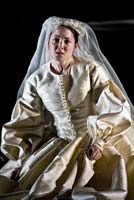ENO
16th February
 During the later part of the eighteenth century the Glass Harmonica was very much in vogue, with composers like Mozart and Gluck writing works specifically for the instrument, and doctors fascinated by its supposed psychological effects. This popularity extended well into the early nineteenth century at which point it rapidly faded from view. This may account for the fact that, until ENO revived Donizetti's original scoring, I doubt if anyone had heard the 'mad'scene from Lucia as the composer intended.
During the later part of the eighteenth century the Glass Harmonica was very much in vogue, with composers like Mozart and Gluck writing works specifically for the instrument, and doctors fascinated by its supposed psychological effects. This popularity extended well into the early nineteenth century at which point it rapidly faded from view. This may account for the fact that, until ENO revived Donizetti's original scoring, I doubt if anyone had heard the 'mad'scene from Lucia as the composer intended.
Certainly none of the present recordings use the instrument, substituting the more familiar flute obliggato, and the equally familiar coloratura which we now know dates from the latter part of the century and was not Donizetti's original concept
The combination of these two alone make for a far more dramatic impact than is often the case. The unearthly hum of the Glass Harmonica, splendidly played by Alexander Marguere, penetrates the auditorium in the way that Messiaen's use of the ondes martinon does in more recent compositions.

 Even David Alden's production, with its now familiar clichés – soloists enter through windows, lights swing erratically, the chorus throw papers around and there are hints of incest and paedophilia – support the decaying society within which Lucia dissolves into insanity.
Even David Alden's production, with its now familiar clichés – soloists enter through windows, lights swing erratically, the chorus throw papers around and there are hints of incest and paedophilia – support the decaying society within which Lucia dissolves into insanity.
Anna Christy is a real find as Lucia. We may have had an apology for bronchitis but one would never have known it from the bravura performance we witnessed. She was finely supported by Barry Banks' heroic Edgardo and Mark Stone's dastardly Enrico.
Clive Bayley had to give up singing after the first scene, but continued to act the part while Paul Whelan sang from the wings. He takes over later in the run but will clearly be a strong addition to the cast.
Orchestral playing was full blooded and heroic throughout. ENO may have had a bumpy season but this has to be the highlight so far.
BH
